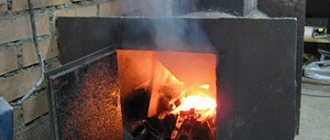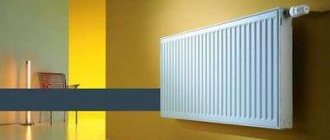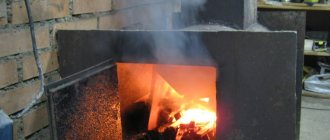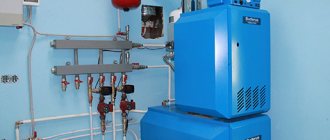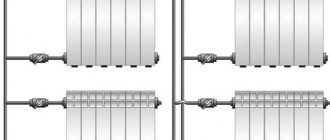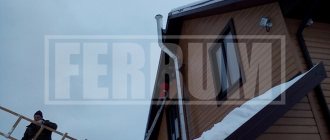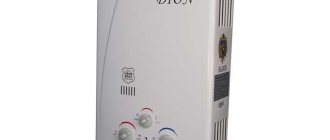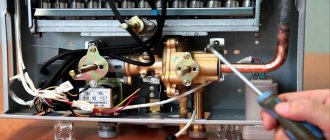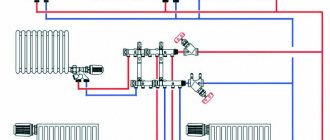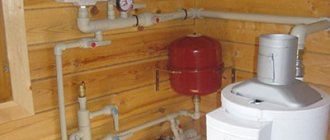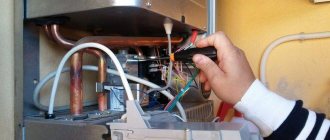Sometimes, immediately after lighting the boiler, smoke comes into the room. This may be due to the weather and a long pause in the operation of the unit - the temperature in the room has become equal to that outside and the draft has disappeared. In this situation, you just need to wait until the chimney warms up and normal air circulation is restored. If combustion products return to the room frequently and regardless of the temperature difference, you should be wary. After all, this indicates serious problems in the system.
Why does reverse draft appear and how to eliminate it?
It is recommended to install the boiler in such a way that the vent and smoker are located on one side.
Failure to comply with the rule in a small building is infrequent, but there may be no consequences. In a high-rise building in windy weather, this can cause a pressure difference. Violation of the norm in this case leads to the appearance of reverse thrust. Often a previously unsmoked boiler lets out clouds of smoke into the room at the moment of lighting after it has completely cooled down. For normal exhaust gas removal, it is necessary that the boiler room be warmer than outside. Violation of this rule leads to a natural result - the draft will not be restored until the heating equipment warms up. You can restore normal air circulation using a simple technique - light the paper, after placing it closer to the chimney. In this case, the ash pan is left open and the firebox door is tightly closed. Attempts are repeated until smoke appears from the chimney, indicating the restoration of normal draft. After such a signal, you can safely start the heating boiler without fear that it will start to smoke.
Solid fuel boilers for the home help create fairly comfortable heating, and can help the heating system cope with increased demands. They have enough advantages, but require maintenance from time to time, and always with care for fire safety purposes.
In this article we will look into this question that often arises among owners, why the heating boiler smokes and what to do in such cases. Often, the problem lies in the chimney pipe.
You can find out the price and buy heating equipment and related products from us. Write, call and come to one of the stores in your city. Delivery throughout the Russian Federation and CIS countries.
Smoke from the boiler into the room
The appearance of smoke due to incorrectly selected chimney dimensions
Another fairly popular cause of smoke is the incorrectly selected height of the chimney pipe, and this error usually occurs during the installation of all equipment
When installing a chimney in a garage or other building, it is important that its outer part, which is located on the street, has the necessary and sufficient height
If the proportions are chosen incorrectly, then very often smoke comes out of the stove, which comes out when the door is opened, and the reason lies precisely in the chimney. If this error is detected, it is necessary to urgently correct it, for which purpose the structure is built up through the use of additional sections of pipe.
If smoke comes into the room from a gas boiler
A wall-mounted or floor-standing boiler and AOGV can smoke for two main reasons: a malfunction of the chimney or poor gas quality.
First of all, it is necessary to inspect the chimney and carry out the following work:
The presence of traction is checked. This can be done either with a special measuring device, or by holding a lit match. The flame should deviate noticeably towards the boiler. If this does not happen, it means that the chimney for some reason does not pull smoke out.
View the pipe using a mirror and a flashlight. If necessary, remove snow and foreign objects. If you cannot do this yourself, call a chimney sweep. If you heat with damp wood, you need to clean out the accumulated tar from time to time. Replace the chimney with a suitable type and diameter for this model. For example, the Lemax Premium device requires a chimney with a diameter of 200 mm. Increase the length of the pipe; in your house, its end should end above the ridge of the roof. Insulate the outside with glass wool. Inspect the chimney for cracks
Pay special attention to connecting seams. Remove right angles when turning and make transitions smooth.
In the room where the gas boiler is located, a window must be open to allow air to enter. This is especially true during the cold season in high-rise buildings, where a layer of cold air may prevent combustion products from escaping.
If you heat with a gas boiler and use cylinders rather than a centralized gas pipeline, it is important to purchase high-quality liquefied gas from trusted manufacturers. The Ross Lux model allows you to do this.
Presence of cracks
It's no secret that over the years the stove becomes covered with a network of cracks and cracks.
Especially at the junction of clay and metal elements, for example, around a slab. Wells can also crack at the seams. The cracks could remain in the place where a knockout brick is inserted for cleaning, or the vent and firebox doors have become loose over time.
Also, atmospheric phenomena sometimes destroy the outer part of the pipe on the roof.
It is possible and necessary to deal with cracks, because air is sucked in, its natural flow is disrupted, and at the slightest disturbance in draft for other reasons, smoke finds its way out, even with the door closed!
The cracks are sealed with clay mortar, similar to the one on which the stove is made. Deep cracks are widened using a knife or similar tool to allow the mortar to penetrate deeper between the bricks. Then the gap is moistened with water and sealed well. Small cracks can be whitened.
Causes of reverse thrust
Backdraft is one of the possible reasons why the boiler smokes when the door is opened. It has already been discussed above. If combustible products are not removed through the chimney, but go into the living room, it is worth analyzing the cause of this situation and urgently starting to troubleshoot. As a rule, in this case, the exhaust gas sensor built into units of all modern brands also reacts.
However, the solid fuel boiler smokes profusely when the door is opened and dirty the window on the door. The reason is usually the same. All gases circulate from an area with high pressure to an area with lower pressure. Natural draft appears when the chimney is brought to the optimal height.
You can check whether reverse draft is present by holding a lit match to the chimney pipe. In the case of natural draft, the fire will be deflected towards the boiler, but if there is a reverse draft - away from the boiler.
The most common cause of backdraft is weather. A gust of wind penetrates the chimney and does not allow harmful waste to escape. The same goes for when the outside air temperature drops. Sometimes you should simply wait until the pipe becomes warmer and the natural circulation of combustion products improves.
It is also possible that the design and type of chimney pipe are not selected correctly. There may be damage. For unhindered smoke removal, the pipe should have as few turns as possible. The diameter and types of the chimney are selected for each boiler based on its type and power parameters.
Where to start checking your furnace
Smoke comes out of the house, and you need to start checking from the roof - from the chimney. If the draft was good, but suddenly stopped, the cause may be an object that blocked the pipe. This happens especially often if there is no cap over the chimney and there are tall trees nearby. Any object can mechanically narrow the chimney channel: a nest made by birds, a brick falling out of the chimney, an accumulation of branches, debris.
If there is no cap, the draft also disappears during strong winds. The air mass creates a turbulence in the pipe and blocks the path of smoke. It comes back and exits through the latches and doors. In calm weather there is no smoke in the house, and from this sign you can already understand its cause.
This equipment is not too difficult to maintain.
However, due to the specifics of its work, it requires some attention during operation. Further in the article we will look at ways to eliminate the most common problems and the reasons for their occurrence.
What to do if the boiler “cries”
Condensate begins to flow out of the boiler when the return temperature is too low. This problem requires elimination, since such a problem reduces the service life of the boiler. Soot and soot accumulate inside the equipment. To avoid such a situation for boilers using pellets and wood, it is necessary to ensure that the temperature of the coolant in the return line is not lower than 55 degrees.
In this case, 60-65 g can be considered the best option. In order to ensure such operating conditions, a Laddomat device or three-way mixing valves should be used.
Causes of overheating of solid fuel boilers and ways to eliminate this problem
A solid fuel boiler can overheat mainly in two cases:
If the premises of the house consume less heat than the boiler itself generates. The features of this equipment are such that precise power adjustment is simply impossible. As a result, the coolant heats up until it begins to boil and release excess steam through a special valve; Approximately the same situation occurs when the circulation pump stops functioning for some reason. In this case, boiling occurs as a result of the fact that heat removal from the boiler ceases.
How to protect equipment from overheating? Experts advise using a special storage tank for this purpose, as well as a UPS (uninterruptible power supply).
The latter is necessary, first of all, to ensure the stability of the pump; the first is intended to collect excess heat. In order to protect the boiler from overheating, it is worth using WATTS STS-20 and REGULUS TSV valves.
Other common problems
Very often, owners of solid fuel boilers are also forced to solve the following problems:
Smokes. The reason is poor draft in the pipe. Most likely, the air heating of a private house will simply need to be cleaned of soot; High fuel consumption. The problem usually lies either in the incorrect connection of the boiler (incorrectly selected power), or in the use of low-quality fuel or poor insulation of the room; Water is flowing from the chimney. In this case, the latter should be insulated; The burner in the pellet boiler becomes clogged. To avoid this, you should use only high quality granules from certified suppliers.
Alternative heating for a cottage or private house
Heat pumps or solar collectors are most often used as alternative sources of thermal energy. The latter can also be a source of electricity. The cost of such equipment at the moment is astronomical and only owners of large, very large residential properties, where such investments will pay off in the foreseeable future, can afford them. In developed countries, governments actively subsidize the use of such equipment. Well, in the former USSR, the use of heat pumps and solar collectors turns out to be much more expensive than gas, coal and even electricity.
If the gas boiler smokes
In addition to errors associated with improper installation of equipment, the quality of the fuel plays an important role in the operation of the unit. This issue is especially relevant when using liquefied gas from a cylinder.
After the combustion of clean fuel, a small amount of dry soot remains. Flakes of this substance accumulated in the pipe can be easily eliminated. It is enough to tap the chimney from the outside and remove the crumbling soot through the technical window.
After the combustion of gas with a large number of impurities, greasy soot adheres to the walls of the chimney, gradually narrowing the lumen. This substance is quite difficult to clean off. A regular pipe brush may be useless. In such a situation, it would be best to disassemble the smoker and clean its components separately.
Quite often, a gas boiler smokes due to improper adjustment of the flame intensity. If the user, in violation of all instructions, turns on the burner of a cold boiler at full power, then the appearance of smoke will be a natural result. The problem can be avoided by gradually increasing the combustion temperature after kindling.
Action plan for a stove smoking in the house:
- Open windows and doors to the street to remove combustion products from the room.
- Extinguish the fire in the furnace firebox.
- Think about why the stove is smoking.
- Check the permeability of the stove and chimney channels.
- Try to create draft in the chimney.
- Try again to light the stove.
If the stove is smoking, ventilate the room immediately.
It is very dangerous to be in a smoky room.
Carbon dioxide released when wood burns in a stove is toxic and when inhaled, poisoning (burning) quickly occurs.
A distressed person begins to feel unwell, dizzy, and have a headache.
With severe intoxication, a person loses consciousness.
Losing consciousness in a smoky room becomes a mortal danger.
Therefore, it is extremely important to immediately get out of the source of smoke.
Extinguish the fire in the firebox.
If you do not know the reason why the stove is smoking, you should not try to heat it further.
Of course, the situation is unlikely to change, and there will only be more smoke.
We wonder why the stove is smoking.
First, we check whether the chimney valves are completely open.
After calming down, think about what could be the cause of the smoking stove.
Often, everything is simpler than it seems when you are in a panic.
We check the permeability of the chimney and channels.
We look for cleaning doors, open them and look inside the stove and chimney.
I usually put a camera in the oven and look at the photographs to see what is happening inside.
(caution, the oven may be hot inside)
- Planted furnace channel.
- Normal furnace channel.
If you see what you think are suspicious foreign objects or heavy contamination inside the oven, you should try to remove it.
One day, a bird fell down my clients’ chimney.
Unfortunately, it was not possible to save the bird, but fortunately, after removing it, the stove began working properly again.
It’s more difficult with soot; if you don’t know how to clean the stove, contact a stove maker or a person who has similar experience. Better not experiment.
If you understand the structure of the stove, it is not difficult to clean it, but if this understanding is not there, then the task may be unsolvable.
If the inside of your stove and chimney is clean, move on to checking the draft.
We create draft in the chimney and channels.
To do this, you need to open the pipe cleaning door (if equipped) and burn several newspapers inside the pipe.
Burn until a stable draft is created in the pipe. (After this, close the cleaning)
The burning paper should be pulled into the pipe with force. If this does not happen, further actions are most often pointless.
Warm up the smoke ducts of the stove itself in the same way.
First, we heat the channels closer to the chimney, gradually moving towards the firebox.
If, at some stage, the craving disappears and is not restored, we look for the reason.
Perhaps there is a congestion there.
If good draft is created in all cleaning doors, we proceed to test kindling.
We try again to light the stove.
Take a small amount of dry wood chips and try to melt them in the furnace firebox.
Before this, do not forget to hermetically seal all the cleanouts through which you heated the pipe and oven.
After igniting the fuel, it is better to close the firebox door and open the ash door slightly, so it will be easier for the stove to light.
Well, if it doesn’t work out, don’t worry, call the stove maker.
What to do when a solid fuel boiler smokes - a real example
The reasons for the smoking of a solid fuel boiler can be different. Often, when such a situation arises, unit owners immediately search for information on the Internet, analyze websites and forums to find real reviews and comments, how to determine the cause of the problems and fix them. Here is one such example.
One of the forum members complained that after installing a solid fuel boiler of the Dragon TA brand with a classic stainless steel chimney, after two years of unquestioning operation, the unit began to smoke. Combustion products began to come out of the chimney inside the boiler room, from all the doors during the firebox.
Kindling was carried out with various types of firewood: spruce, birch, aspen. Dry, wet, and frozen firewood was used... The boiler functioned perfectly for two years, and then the situation changed. The owner is sure that weather conditions have nothing to do with it. Ventilation works great.
The actions of the boiler owner were as follows:
- He dismantled the chimney pipe and cleaned it.
- I rewound all the connections of the structure with aluminum tape.
- Cleaned out the entire boiler.
- The chimney was insulated with 10 cm ROCKWOOL stone wool.
The solid fuel boiler was still smoking inside the boiler room, but the chimney stopped. The owner did not understand what was wrong and why the boiler was smoking.
After much deliberation and communication with people who had encountered a similar problem, we were able to establish the reason, which was as follows.
The owner heated the boiler for two years with dry chopped aspen and birch logs. In the real cold season, the weather arrived already in October, so we ran out of dry firewood, and a carload of raw birch firewood was purchased.
When using dried firewood, dry soot accumulated in the chimney pipe, which could be removed simply by tapping the vertical part of the chimney with a stick. And everything is clean and tidy. Damp birch logs covered the walls of the boiler and chimney pipe with tar.
The owner carried out all the necessary cleaning procedures for the boiler. Removed the tar. And that's it - the problem disappeared.
A solid fuel heating boiler is a good means of heating. But remember that it also requires periodic maintenance and compliance with safety rules.
The boiler is smoking: causes and solutions
Miscalculations during laying a stove well - what to do now?
In some cases, smoke enters the house the moment the firebox door is opened. When the door is closed, carbon monoxide is evacuated as usual. In this case, the reason lies in the inexperience of the stove master.
When the door is opened, smoke occurs if the entrance to the well is located too low and the shortest path for heated air with carbon monoxide runs precisely towards the doorway of the firebox.
For any responsible person, when the stove in the house smokes, what to do is the main and primary question. The problem can be solved if you build a wall inside the firebox, the upper edge of which will be several centimeters higher than the upper edge of the door.
Thus, hot air with carbon monoxide will move to the well opening even when the firebox door is open.
Results
In the article, we looked at the most likely causes of smoke inside the house, as well as what ways you can deal with it. It is noteworthy that in most cases the work is not difficult and can be done independently.
What problems arise when operating solid fuel boilers?
1. When loading fuel into the boiler, smoke comes out into the room - The main reason for boiler smoke is insufficient draft in the chimney, lack of supply air for combustion. Check the condition of the chimney. And most importantly, consult with engineers about the height and diameter of the chimney.
2. Resin adheres to the internal walls of the solid fuel boiler - Raise the operating temperature of the boiler to at least 75 degrees, clean the boiler, install a three-way mixing valve to control the temperature of the water entering the boiler to at least 61 °. Use quality fuel!
3. Periodically, water appears under the solid fuel boiler - this is condensation. This process occurs when the boiler return temperature is below 51°; to solve this problem, it is necessary to increase the boiler temperature to 75° and install a three-way mixing valve to maintain a stable return temperature of at least 55°.
4. Black smoke is coming from the chimney - There is not enough supply air for combustion, or low-quality solid fuel is used.
5. The fuel in the boiler does not burn - The chimney draft is weak. The chimney needs cleaning or the cross-sectional height of the solid fuel boiler chimney needs to be increased. Study the boiler instructions and adjust the regulators.
6. The boiler often clogs - Increase the boiler temperature, use higher quality fuel. There is not enough air flow or draft in the chimney.
7. Wood burns normally, but coal does not burn - The size of the chimney does not correspond to the power of the boiler.
8. When heating water in the heating system, the pressure rises greatly - The expansion (compensation) tank is damaged or has insufficient volume.
9. Which safety group should be set for a solid fuel boiler - The safety group must comply with the manufacturer’s requirements specified in the instructions for the boiler.
10. The solid fuel boiler cannot raise the temperature in the heating system – Raw fuel with insufficient caloric content is used, replace the fuel with a higher calorific one. For example, briquettes or coal. You need to use more or less dry fuel.
The main problems with solid fuel boilers arise from improper installation and selection of the chimney for the boiler. Also, the operating temperature of a solid fuel boiler plays an important role, as well as the temperature of the heating return line (the water that enters the boiler) must be at least 55°. When purchasing a boiler, analyze the fuel market, consult with specialists on boiler installation plans
Also, it is worth paying great attention to the type of boiler and the types of fuels on which the solid fuel boiler can operate
There are four main types of solid fuel boilers - universal boilers, wood boilers, pellet boilers, and combination boilers. These boilers differ greatly in terms of comfort and quality of operation using one or another type of solid fuel.
A lot depends on whether you are ready to use solid fuel in heating your premises, since it will take a lot of effort and time when using manual fuel loading, so you should immediately decide whether you need a boiler with manual loading or automatic.
And don’t forget to call and consult - this will give answers to many questions, and it will also show the level of engineers who offer you quite specific equipment!
Conclusion
The most common reasons for stoves smoking in the house are poor draft and soot-covered structure inside. Moreover, if the system begins to become overgrown with “fluffy” soot, then it needs to be cleaned urgently, as it can catch fire, which is a fire hazard.
If you promptly check the chimney for soot fouling and clean it when blockages are detected, then smoke in the room will rarely occur or will not occur at all. It is also necessary to constantly check the entire structure to identify various damages, cracks, breaks, and so on - they are also a common cause of smoke.
Why the boiler smokes reasons
Let's figure out why the boiler smokes and what are the main possible reasons for this phenomenon. Most likely the problem is in the chimney.
Here is a list of supposed malfunctions in this unit leading to poor traction:
- The chimney pipe is clogged. In winter, it could get snowy or freeze. Also, a foreign object could get there from above or soot could gradually accumulate. All this can be the reason why there is no traction.
- When burning wood that is not sufficiently dried, tar accumulates, which greatly narrows the diameter of the pipe and increases the thickness of its walls, preventing it from warming up sufficiently.
- The diameter or type of chimney does not match the power of the model.
- Insufficient height at which the pipe ends. In this case, the pressure difference will not be enough to produce natural traction.
- Crack or leaking joints in the chimney. Too sudden changes in direction and turns of the pipe, where plugs of cold air form.
A sudden change in weather may also be the cause. During the cold season, the craving is stronger than at high temperatures. When there are strong gusts, the wind blows from above into the pipe.
Unsuitable or poor quality fuel also causes smoke. For example, gas with a large number of impurities, wet firewood, foam or other synthetic materials entering the solid fuel boiler
You should also pay attention to the degree of opening of the gate
Smoke comes into the room if air does not enter the boiler room when the boiler is operating. For safety reasons, there must be an air supply from the same side of the house as the chimney. Otherwise, strong wind can lead to a pressure drop and the formation of smoke inside the room.
A clogged boiler or a reduced flow area of the grate can also cause smoke. The device also smokes at the very beginning during kindling, due to the fact that the chimney pipe has not yet heated up.
Prevention
The best method to get rid of problems with the stove is prevention:
- Timely cleaning of chimneys will protect you from blockages. It is recommended to do this at least once a year. When you use a lot of fuel, or if the fuel itself burns, producing too much soot, it is a good idea to have your chimneys cleaned twice a year.
- Monitor the condition of the chimney pipe. It is enough to do a visual inspection of its condition once a year. Secure the brick pipe parts using clay or cement mortar with sand. Use clay for work inside, cement for outside. Repair cracks. Monitor the condition of the insulation and insulation of the metal pipe. Strengthen it in a timely manner if you notice damage.
- Remember to maintain your oven when it is not in use. Try to paint all its metal elements with heat-resistant paint. This will extend the service life. Protects against corrosion. Examine the internal condition of the firebox of a brick kiln. If necessary, replace damaged bricks and grates with new ones. Check the condition of the welds on the metal stove and repair them if you see cracks.
With these simple tips, you can troubleshoot your stove and also keep it in working order so that it warms you with its warmth on cold winter evenings.
The video below shows the reasons why the stove smokes and how to fix it:
Troubleshooting solid fuel models
Solid fuel boilers may have the same causes of smoke associated with the chimney as gas appliances described above. When burning, it is necessary to use well-dried raw materials. It should be stored in well-suited places with low humidity. Do not use synthetic materials as fuel.
Wood-burning boilers such as Buderus Logano SW, Stropuva S and Zhitomir D should be heated only with dry wood. To be able to use different types of fuel, you need to purchase combined devices such as KST or Dymok. You can experiment with the degree of opening of the gate in air-heating models, such as. If smoke appears, make the chimney opening larger.
Ensure air flow into the boiler room. For safety reasons, the window must be open constantly while the boiler is operating during the heating season. The device operating on solid fuel must be cleaned regularly. This is especially true if it is coal or diesel, running on exhaust, since these types of fuel clog the burner especially quickly.
Troubleshooting
All possible answers to the question “Why?” described above. And now the second question: “What to do?” if a solid fuel heating boiler smokes?
For kindling, you need to choose only dried logs, which should be stored under special covered sheds so that minimal moisture gets on the fuel. There is no need to use artificial materials as fuel.
Heating devices such as Buderus Logano SW, Stropuva S and Zhitomir D are heated only with dried wood. If you want to use different types of fuel, you should think about purchasing universal units, for example, KST or Dymok.
You can test the degree of gate opening in air-heated versions, such as Siberia. If smoke appears, the chimney opening should be made larger.
It is necessary to ensure the flow of air masses to the boiler. According to safety rules, the window must be open all the time while the boiler is operating during the heating season. A solid fuel boiler needs to be cleaned from time to time.
Shed for firewood made of profile pipe and polycarbonate
Causes of boiler smoking
Some signs help determine what to look for first when smoke and soot appear in the room. Conventionally, the causes of smoke can be divided into 4 groups:
- A clogged chimney pipe is one of the most common problems. This could be either a foreign object that has entered from outside, or the result of using low-quality fuel.
- The discrepancy between the chimney and the boiler power or the height of the building is less common and is detected almost immediately, during the first fires. In a situation where at first everything was fine, and then it began to smoke, this reason should not be considered.
- Damage to the chimney is the least likely case. But if the boiler is smoking at the beginning of a new heating season, then inspecting the pipe should be one of the first tasks.
- Weather conditions affect natural draft in only two cases: low chimney height and incorrect location of the fresh air inflow point.
The smoker must be raised above the roof ridge. The diameter of the pipe is selected in strict accordance with the power of the boiler: a small cross-section simply cannot cope with the removal of smoke from a serious firebox. You should also avoid right angles in places where the pipe changes direction - this impedes air circulation, which does not have the best effect on traction. A visual inspection allows you to identify these shortcomings and eliminate them.
Soot removal accessories
People often wonder: why does a Russian stove smoke? Are the possible causes remediable? When smoke appears from this massive object (as well as from any other “queen of fire”), first check the draft. It is unacceptable for it to be bad or absent. The ventilation effect formed due to the temperature difference between the outside and inside the pipe is something without which there is and cannot be a single “white” stove. “Black” is pipeless, the oldest, they say it is more hygienic, fungi die in it, but it is unlikely that a modern person is ready to wash or live in a “grimy” smoke-filled room.
Over time, the smoke exhaust tunnel walls become covered with a layer of soot. It is believed that even a build-up of just three millimeters significantly reduces the heat transfer of the furnace. There are devices for removing soot. You can borrow it from your neighbors or make it yourself. Option 1: take a nylon washcloth made of thick thread, place it with a weight-stone in an old string bag (strong mesh), pass a rope through the handles. And for cleaning!
Goods, services
15.04 05:45
Questions about products and services, complaints and reviews
Gentlemen! help, I have a Buderus solid fuel boiler, it worked fine for a month, then it began to puff, I asked whoever I asked, no one knows!
Continue topic
If you want, let's meet on the spot and figure it out. I have the same boiler and the same problems arise.
Insulate the pipe and you will be happy, at least until you grow
It's just time to clean it
look at the pipe. length and condensate. wrap the pipe.
There can be a lot of reasons - if there is forced ventilation - something with the motor or fan... With the smoke pipe itself, its outlet... with the casing of the working area of the boiler (depressurization somewhere)... Are the grates okay? lack of air flow due to them, including... Is there soot in the pipe? Check in order - starting with the grate and further along the smoke path... By the way, soot depends on the coal... it can burn very quickly if the pipe diameter is small..., look at the outlet from the boiler at the narrowing...
the pipe is 160 in diameter, insulated, I opened the hatch on the pipe and it was clean, the grates were also normal, I clean the boiler every week. (Added after 5 minutes)
it begins to puff after 2-3 hours of operation, when it is in operating mode, i.e. muffled, I tried opening the tertiary air windows, it does not puff, but it starts to burn strongly, because of this, an increase in temperature and pressure!
It puffs for 3 reasons (that I know of): 1. The boiler was not cleaned enough. (there is an adjustable damper in the transition pipe from the boiler to the chimney - it needs to be cleaned and the transition itself, chambers 2 and 3 were not cleaned enough, it is also advisable to clean the exhaust pipe itself with a long wire, there may be pieces of soot on the walls) 2. The coal is very fine (I tried one small thing - almost dust and sand, it burns, but it puffs, so I interfere with the middle pieces) 3. The boiler has completely suffocated - there is not enough air. (but this is rare, a lower flap of 3-4 mm is quite enough)
Load more
How to check the quality of smoke exhaust?
Checking the draft in the chimney is necessary to prepare for activities before cleaning. Testing is carried out in several ways:
- using an anemometer. Professional specialists work with high-precision devices. To know how to check the draft in a chimney, it is recommended to study the instructions for the anemometer;
- by setting the paper on fire. The sheet is brought to the chimney grate - a high-quality arrangement of the hood helps to attract the flames upward. If there is no draft, the flame will remain in place;
- visual method. A dark red light indicates insufficient hood power. The quality of the pipeline’s functionality is determined by an almost white flame.
Another option for identifying breakdowns is by smelling smoke.
A strong aroma from the stove is a sign of clogged flue ducts.
Preventive measures
It is necessary to clean not only the chimney pipe from the formation of plaque, but also other parts of the potbelly stove. Thus, you should pay attention to the following parts of the design:
- Layers of soot also form in the ash drawer, ash pan and space under the oven, which can cause the potbelly stove to smoke.
Important: If you notice the formation of smoke when you open the door, you should pay attention to what the weather is like outside: if this only happens during windy times, simply installing a windproof deflector cap will help.
- It would be a good idea to check the structure for flaws and cracks that could have formed due to improper assembly of the stove. Correcting these shortcomings will help to properly direct the smoke draft.
- Sometimes the stove smokes because the door does not fit tightly enough. In this case, either the element is replaced or the surface of the potbelly stove is leveled.
Only high-quality raw materials should be used as fuel and not replaced with sawdust and straw.
The burner flame has blown out - we solve the problem with the chimney
If your autonomous gas boiler constantly blows out, first look for problems in the chimney design. Pressure drops in a gas pipe occur extremely rarely, and the pressure drop is insignificant. A technical malfunction of a gas boiler, due to the simplicity of the design of heating equipment and the high degree of reliability of modern models, is also unlikely.
The most common situations encountered related to the chimney:
- ice crust covering the ventilation duct of the heating device - the formation of an ice cap inside the chimney prevents air circulation, putting the gas boiler in a state of oxygen starvation (along with combustion products, water vapor enters the chimney duct, condensing and freezing on the walls of the chimney);
- reverse draft that occurs when the wind increases or changes direction (a strong air flow, entering the chimney, reaches the combustion chamber and extinguishes the flame in the boiler).
In the first case, frozen condensate creates an artificial obstacle to the air flow. In such a situation, the chimney must be cleaned and insulated, allowing the condensate to simply drain down.
In the second case, the situation is dangerous. With the reverse movement of warm air, strengthened by gusts of wind, there is a high probability of the burner flame extinguishing. Good automation will work when the burner goes out, stopping the gas supply to the firebox. However, combustion products will first enter the heating device, contaminating the combustion chamber in the gas boiler, and then begin to enter the living space. The reason for this effect is obvious - the insufficient height of the chimney.
